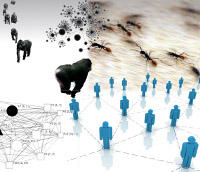Orateur
Mme
Julie Samy
(Department of Biology, University of Maryland, College Park, USA)
Description
Corresponding Author: jsamy@umd.edu
Despite a long history of interactions between humans and elephants, very little is known about Asian elephants, Elephas maximus, in the wild. Sri Lanka has the highest density of Asian elephants and is one of the few places where behavioral observations of wild individuals are still possible. There have been only two detailed studies on wild Asian elephant social behavior and each focused on associations between adult females. While both studies found loose associations among individuals, one suggested that females form small cliques whereas the other found preferred associations within a large community. Neither study attempted to determine if association stability differs among sex or age-classes of individuals. To better understand the social structure of Asian elephants, we performed social network analysis based on data from a population of 164 individually identified elephants at Yala National Park in Southeast Sri Lanka. We examined associations between all dyads based on the gambit of the group and considered individuals to be part of the same group if they were within 10m and exhibited synchronous movements. We calculated a modularity index for the whole population, a half-weight association index for each dyad, and both betweenness and clustering coefficients for each individual. Our results show that most sub-adult and adult males are solitary, while adult females, sub-adult females and infants show non-random associations. In agreement with one of the previous studies, groups of females and infants form small communities, which are independent of each other. However, within each community individuals maintain preferred associations over time, supporting the idea of a fission-fusion type social dynamic with strong social bonds among some individuals. Dyads that display the highest association indices involve infants, suggesting that group cohesion in Asian elephants probably involves matrilineal groups.
Auteur
Mme
Julie Samy
(Department of Biology, University of Maryland, College Park, USA)
Co-auteurs
Dr
Gerald Wilkinson
(Department of Biology, University of Maryland, College Park, USA)
Dr
Katerina Thompson
(Department of Biology, University of Maryland, College Park, USA)
Dr
Peter Leimgruber
(Department of Conservation Biology, Smithsonian Conservation Biology Institute, National Zoo, Washington DC, USA)

